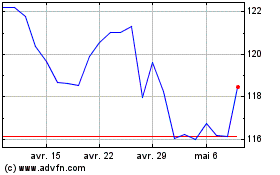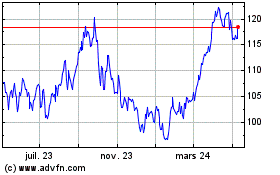Exxon's Well-Timed Hop Onto Carbon-Capture Bandwagon -- Heard on the Street
08 Février 2021 - 1:29PM
Dow Jones News
By Jinjoo Lee
All the cool kids are doing carbon capture.
Exxon Mobil is the latest to embrace the trend, announcing on
Feb. 1 that it has formed a new business unit to commercialize its
low-carbon technology portfolio, mostly comprising carbon capture
and storage. The move comes on the heels of reports that a pair of
activist investors are pushing the company for changes. One of
those, Engine No. 1 LLC, reportedly is planning a proxy fight for
board seats.
Exxon's timing fits a pattern. Occidental Petroleum launched its
low-carbon business -- dubbed Oxy Low Carbon Ventures -- in 2018, a
year after shareholders pressured it to assess the long-term
climate impacts of its business. As the industry faces questions --
both from its own investors and from governments -- about its role
in the energy transition, many in the oil-and-gas sector have
announced some form of investment in the technology, however small
the dollar amount.
Both Exxon and Occidental's moves followed shareholder pressure,
but they are timely for other reasons, too: The stars are aligning
just so on the policy front.
The oil-and-gas industry has in fact been using carbon capture
well before global warming became a concern, mainly to produce even
more hydrocarbons. Since the 1920s, the industry has used it to
sift out unprofitable carbon dioxide that naturally occurs in
natural-gas reservoirs from valuable methane. Starting in the
1970s, drillers began using it to squeeze more oil out of
reservoirs.
The difference today is that companies are committing
substantially higher dollar amounts toward advancing expensive
techniques for capturing carbon dioxide that is more dilute than
the concentrated forms that can be found in natural-gas
processing.
Exxon said its low-carbon business unit plans to spend $3
billion through 2025 and that it is looking at projects and
partnerships that capture carbon from other sectors, too. The
company already has spent more than $10 billion on lower-emission
investments since 2000, so the new commitment means the company
would be increasing its investment into the space by roughly 20% on
an average annual basis.
That sounds like a lot but, based on the conservative end of
Exxon's companywide spending program, its allocation toward
low-carbon technology would amount to roughly 3% of its capital
expenditures over that period. Even if the payoff is unclear,
spending $600 million a year is a relatively modest price for
calming investors' sustainability concerns and hedging against any
future costs that could be placed on carbon emissions. For context,
a sentiment-driven 1% price swing for Exxon means a gain or loss in
market capitalization of more than $2 billion.
Oil-and-gas companies have been laying the policy groundwork for
some time: Exxon was among the first oil companies to lobby for a
national tax on carbon. Placing a price on it would certainly
increase compliance costs for energy companies, but it also opens
up an entire market of emitters -- including cement, steel and
chemicals plants -- that also would need to start capturing
carbon.
The stars have aligned in other policy areas, too. A federal tax
credit for carbon capture has been around since 2008 but only
became a substantial carrot for new investment since 2018, when
rules were amended to increase the tax-credit value and to remove
annual caps on the amount of captured carbon that could use the
subsidy. A tax-extender bill from last year also pushed out the
term of the tax credit by two years to Jan. 1, 2026. On a state
level, California in 2019 began allowing captured carbon to qualify
for tradable credits under its low-carbon fuel standard.
Drillers are familiar with expensive bets with uncertain
payoffs. Compared to their normal course of business, carbon
capture is a modest investment with predictable returns -- if not
in dollars, then in investors' peace of mind. In other words, a
no-brainer.
Write to Jinjoo Lee at jinjoo.lee@wsj.com
(END) Dow Jones Newswires
February 08, 2021 07:14 ET (12:14 GMT)
Copyright (c) 2021 Dow Jones & Company, Inc.
Exxon Mobil (NYSE:XOM)
Graphique Historique de l'Action
De Juin 2024 à Juil 2024

Exxon Mobil (NYSE:XOM)
Graphique Historique de l'Action
De Juil 2023 à Juil 2024
